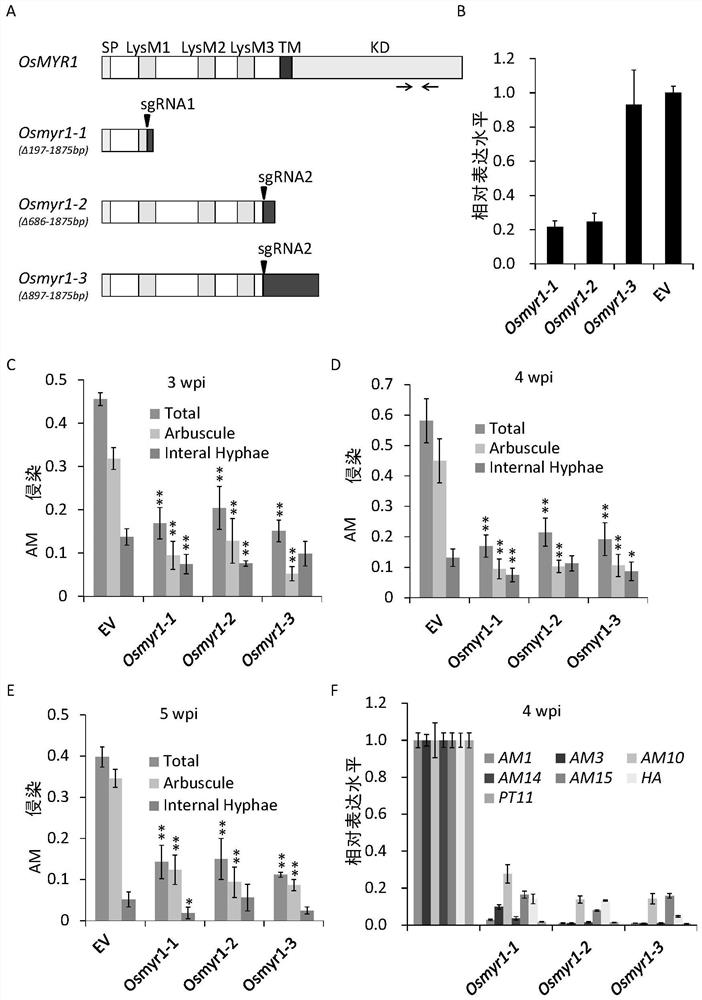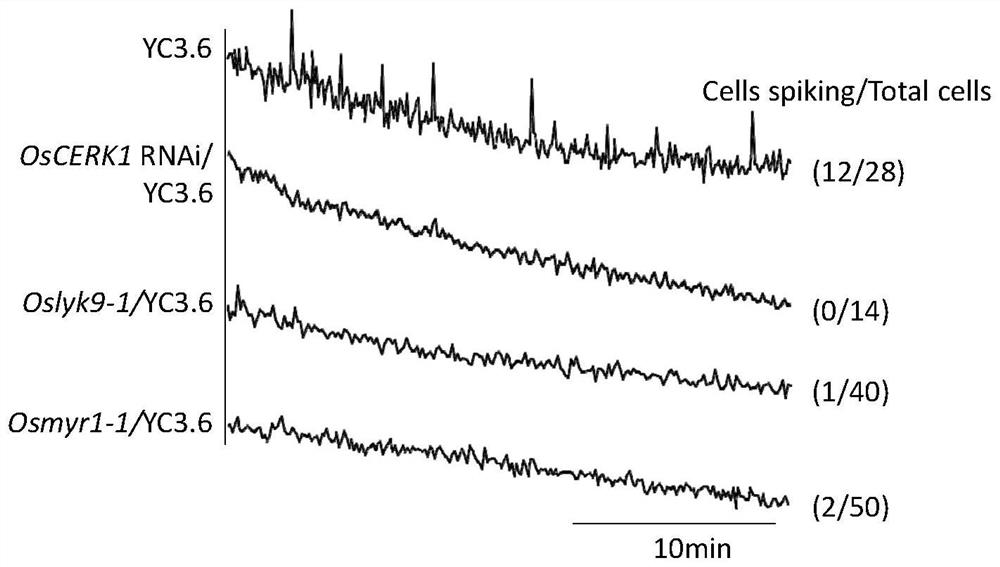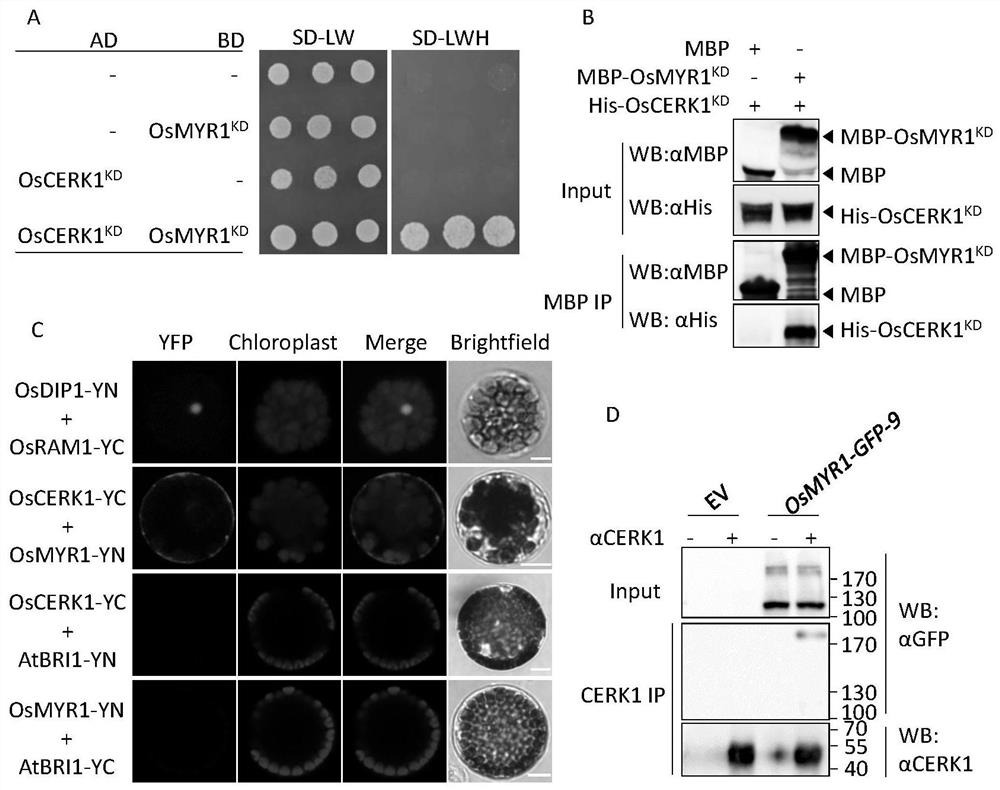A method for engineering cereal crops to recognize nodulation factors and increase the number of rhizobia colonization
A nodulation factor, rhizobia technology, applied in the fields of biotechnology and botany, can solve the problems of energy and resource waste, environmental burden, and increase production costs
- Summary
- Abstract
- Description
- Claims
- Application Information
AI Technical Summary
Problems solved by technology
Method used
Image
Examples
Embodiment 1
[0202] Example 1. Analysis of mycorrhizal symbiosis level of Osmyr1 mutants
[0203] Through CRISPR / Cas9 site-directed mutagenesis technology, the inventors isolated and obtained three OsMYR1 homozygous mutant lines Osmyr1-1, Osmyr1-2 and Osmyr1-3. Their mutations are as follows ( figure 1 A):
[0204] Osmyr1-1: Deletion of 1 base, resulting in premature termination of protein coding in the LysM1 domain.
[0205] Osmyr1-2: Deletion of 1 base results in a frameshift of the OsMYR1 gene during protein translation and premature termination in the extracellular domain.
[0206] Osmyr1-3: Added 1 base, resulting in a frameshift of the OsMYR1 gene during protein translation and premature termination in the intracellular domain.
[0207] Quantitative PCR analysis showed that the transcript levels of OsMYR1 in Osmyr1-1 and Osmyr1-2 were down-regulated to 0.22±0.03 and 0.25±0.05, respectively, while the transcript levels of OsMYR1 in Osmyr1-3 did not change significantly (0.93±0.20) ...
Embodiment 2
[0209] Example 2. Detection of responsiveness of Osmyr1 and Oscerk1 mutants to Myc factor CO4
[0210] Calcium oscillations induced by Myc factors in root epidermal nuclei are a hallmark event of the activation of mycorrhizal symbiotic signaling. In order to study the response of OsMYR1 to Myc factors, the inventors introduced the calcium ion genetic probe YC3.6 (transgenic material stably expressing the YC3.6 element in the nucleus) into the Osmyr1-1 homozygous mutant by genetic hybridization, thereby To observe the calcium oscillation response of Osmyr1-1 mutants to Myc factors. Myc factors, including Myc-LCO and CO4 / CO5, both induce calcium oscillations in rice non-root hair cells and promote root morphogenesis. However, since there are commercial high-purity CO4 products currently on the market, the sources of which are more stable and convenient, the inventors used CO4 as a representative to study the response of rice to Myc factors. The inventors found that 10 -8 MCO4...
Embodiment 3
[0212] Example 3. Study on the protein interaction between OsMYR1 and OsCERK1
[0213] First, the present inventors used yeast two-hybrid (Yeast-2-hybrid, Y2H) and Pull-down technology to detect the interaction between OsMYR1 and OsCERK1 in vitro. The OsMYR1 and OsCERK1 intracellular domains were cloned into pGBKT7 (BD-OsMYR1 KD ) and pGADT7(AD-OsCERK1 KD ) vector, and then the above vector was combined with pGBKT7 and pGADT7 empty vector, and then transferred into yeast cells, and then screened and cultured on the nutrient deficiency medium SD-LWH (-Leu / -Trp / -His). The inventors found that only co-expression of BD-OsMYR1 KD and AD-OsCERK1 KD of yeast cells can grow on auxotrophic medium, which means that OsMYR1 KD and OsCERK1 KD able to interact in yeast cells ( image 3 A). MBP-tagged OsMYR1 fused in in vitro Pull-down experiments KD (MBP-OsMYR1 KD ) can effectively bind to His-OsCERK1 KD protein( image 3 B), further demonstrating that the intracellular domains o...
PUM
 Login to View More
Login to View More Abstract
Description
Claims
Application Information
 Login to View More
Login to View More - R&D
- Intellectual Property
- Life Sciences
- Materials
- Tech Scout
- Unparalleled Data Quality
- Higher Quality Content
- 60% Fewer Hallucinations
Browse by: Latest US Patents, China's latest patents, Technical Efficacy Thesaurus, Application Domain, Technology Topic, Popular Technical Reports.
© 2025 PatSnap. All rights reserved.Legal|Privacy policy|Modern Slavery Act Transparency Statement|Sitemap|About US| Contact US: help@patsnap.com



